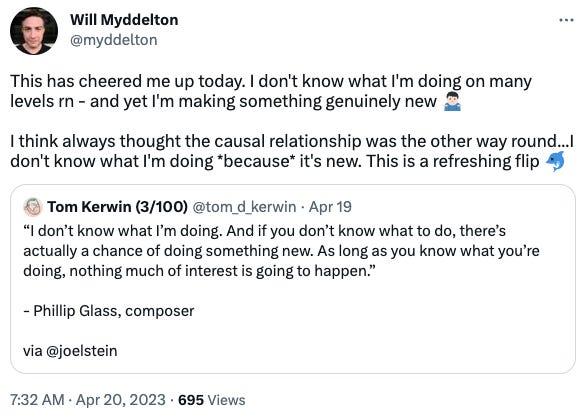If you don’t know what to do, there’s actually a chance of doing something new.
AKA feel the fear and do it anyway.
“If you don’t know what to do, there’s actually a chance of doing something new. As long as you know what you’re doing, nothing much of interest is going to happen.”
– Phillip Glass, composer.
Fellow Pip Decks author
shared the quote above, and it resonated so hard.Early in my design career, I’d get so STUCK when I didn't know what I was doing.
I’ve seen the same pattern in many teams I work with too.
Here’s what stuckness looks like:
procrastination
another meeting to debate abstract ideas and “get aligned”
waiting for other people to make decisions for you
starting with the ‘safe’ stuff – like spending days designing a stunning login screen for a product, studiously avoiding any of the squicky, uncertain parts that customers might actually care about. (Ironically, working on the ‘safe’ parts first like this only makes things riskier.)
(I admit, I used to waste days crafting beautiful shiny button effects or polishing fancy navigation thingumbobs for websites that had no content. No customer is coming to admire your shiny button. I now know I shoulda started with the hard bit: the content.)
Here’s what stuckness sounds like:
“We need to follow the process!”
“We need a clear vision!”
“What's our strategy? Why is it changing?”
“What are the requirements?”
“Which features should be in the MVP?”
“Does anyone have a template I can use?”
“We need to understand the user problem before I can come up with the right solution.”
Hearing or saying any of the above is a niggling little signal that you’re waiting to know what you’re doing before you start.
Signals that you’ve been fooled by what Erika Hall rather brilliantly called “the Illusion of Deterministic Innovation.”
Signals that you’re scared. Scared to start before you know the answer. (Probably because you’re terrified of looking like you don’t know what you’re doing. Most of us are.)
I’m not saying, “don't put in any effort to understand the user problem. Don’t craft a vision. Don’t think strategically.”
Of course you need those. You need just enough of them.
But most teams who embrace research, outcomes, all that good stuff end up going way, way beyond just enough. They get stuck by waiting for certainty before they start work.
What they don’t realise is that there’s no “there” there.
Problems, Solutions, Needs, Strategy, Vision – these aren’t truths you uncover, they’re explanations you collectively create, improve and update.
They’re a set of stories you use to help you make sense of messy reality, so you can make some kind of reality-based progress together.
And those stories you tell should always be changing, both because the world is changing, and because your perception and understanding of the world is changing.
This means:
There’s no place you can reach where “understanding the user” is completed.
There’s no level of confidence you can reach where strategy can be set in stone.
There’s no moment of revelation when your vision is a perfect augury of the future.
… and all that’s OK. We’re all figuring this stuff out as we go. As long as you don’t know what you’re doing, you have a chance of doing something new.
Look, you can spend yet another hour — another 6 months! — circling around all the questions you have. You’ll still have all those questions – and you’ll also be exactly 0% closer to making progress.
Your strategy will never be a plan that you can blindly follow toward an inspiring vision that was handed to you by some kind of omniscient authority.
User problems aren’t lying around out there like acorns on the forest floor.
There is no world in which the right answer will just drop into your lap and your team will immediately recognise its brilliance.
You have to figure the answer out by taking action on those uncertain things you’re most afraid of.
My work for the past decades has all been about enabling myself and the teams I work with to embrace the fear, accept that we don’t know exactly what we’re doing, and move forward in an effective way to figure it out together.
That work includes my Innovation Tactics deck (pre-orders open now!), my Innovate Confidently course (next cohort this May), and coaching (reply if you’re interested).
It’s all because I first had to teach myself how to do that simple but upsettingly hard thing: feel the fear and do it anyway.
“Start where you are. Use what you have. Do what you can.” – Arthur Ashe
Thanks to
for inspiring this rant, and to for editing my invective.


